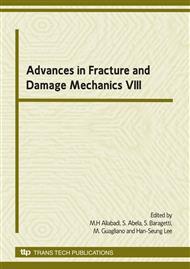p.673
p.677
p.681
p.685
p.689
p.693
p.697
p.701
p.705
Numerical Simulation on Damage and Failure of Recycled Aggregate Concrete with a Lattice Model
Abstract:
A random aggregate model of recycled aggregate concrete is developed in this paper on the base of a mixture ratio. Combining a lattice model with random aggregate of recycled aggregate concrete, lattice elements in the lattice model of recycled aggregate concrete can be classified into five types: (1) nature aggregate, (2) old hardened mortar, (3) new hardened mortar, (4) old interface transition zone (ITZ), and (5) new ITZ. The fundamental mechanical parameters of the lattice elements are chosen from the authors’ test as well as other references. A FORTRAN program of the lattice model is then written with basic theories of finite element method (FEM) for simulating the meso-structural damage of recycled aggregate concrete under uniaxial compression.
Info:
Periodical:
Pages:
689-692
Citation:
Online since:
October 2009
Authors:
Price:
Сopyright:
© 2010 Trans Tech Publications Ltd. All Rights Reserved
Share:
Citation:


